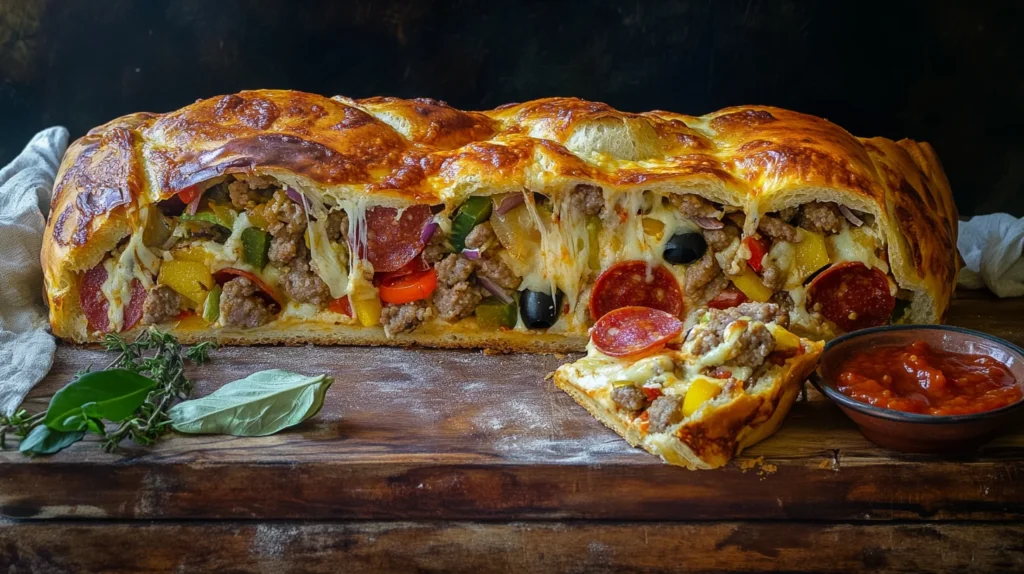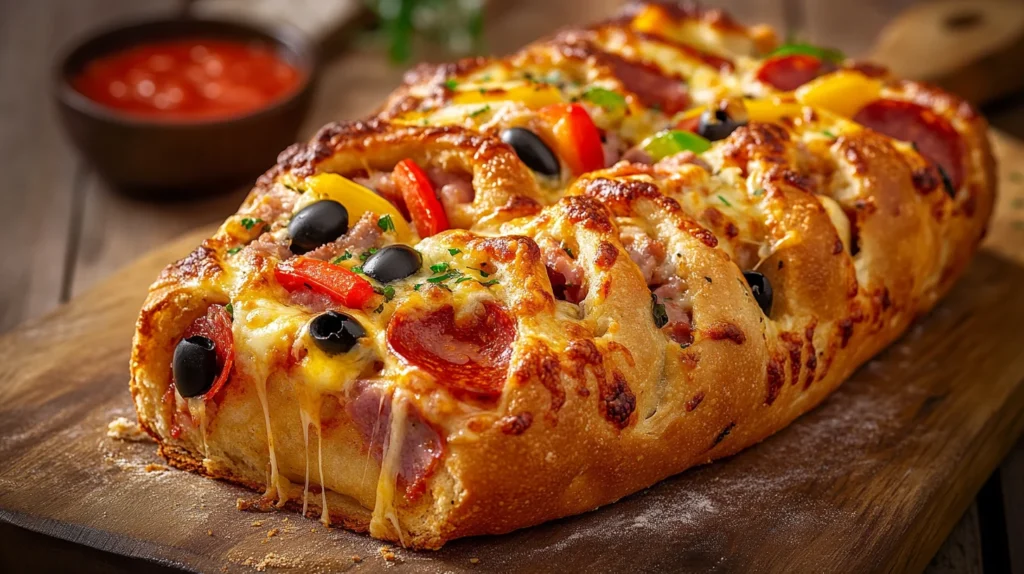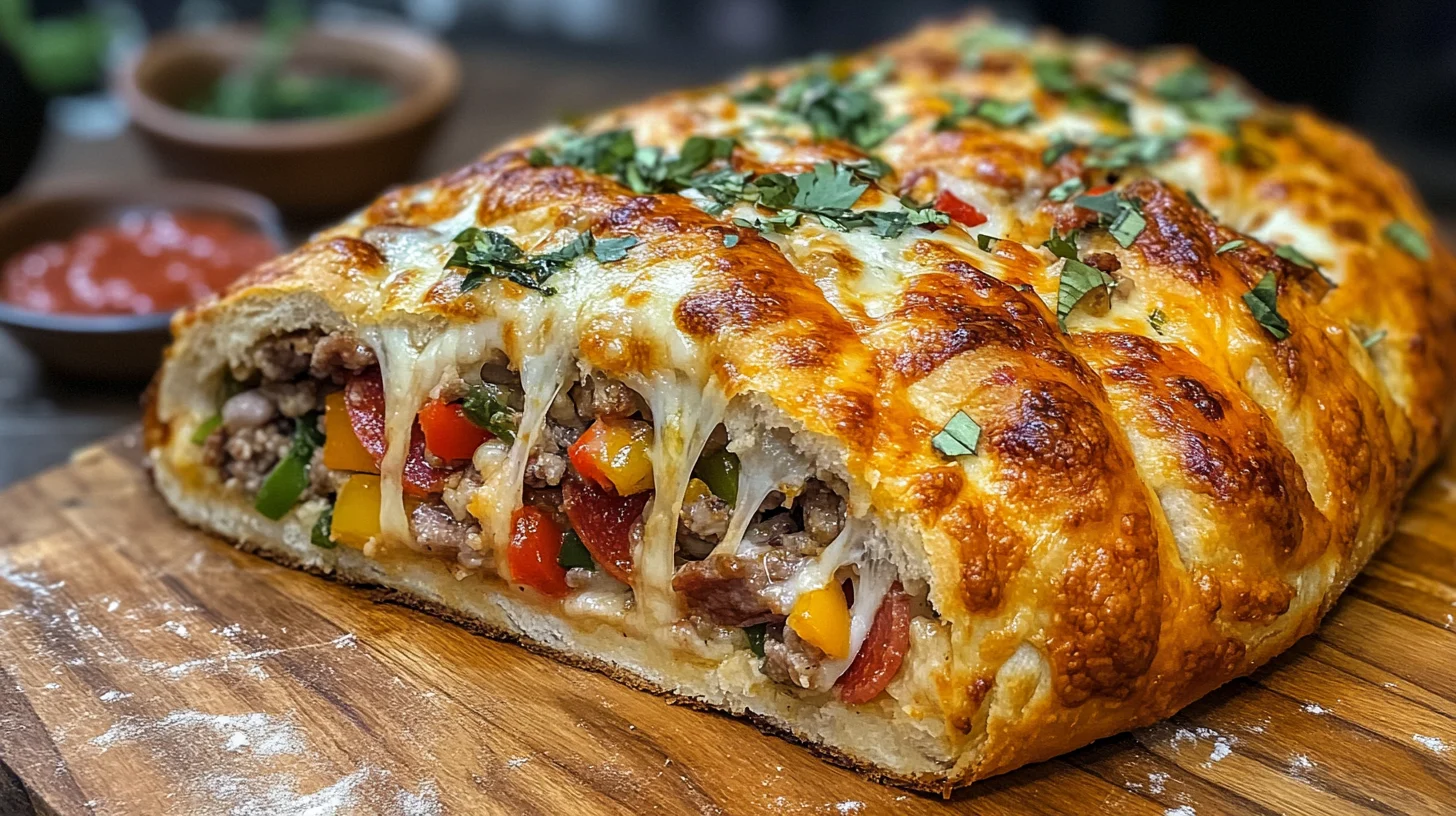Easy Garbage Bread Recipe: Cheesy & Savory Stuffed Delight
When it comes to crafting delicious, comforting meals at home, few things can rival the charm and versatility of a Garbage Bread Recipe. This unique dish combines all your favorite ingredients into one portable, savory treat, making it not just a meal but an experience. Whether you’re looking for a way to use up leftovers or simply want to impress your friends at your next gathering, garbage bread is your answer. Join us on this culinary journey as we explore the ins and outs of creating your very own garbage bread.
The Ultimate Guide to Crafting Delicious Garbage Bread
Garbage bread may seem like a quirky name, but its origins are steeped in creativity and practicality. Born out of the need to minimize waste and maximize flavor, this hearty dish is beloved by home cooks around the world. In this guide, we will delve deep into understanding what garbage bread is, why it has captured the hearts (and stomachs) of many, and how you can create your version at home.
Understanding Garbage Bread: A Culinary Delight
Garbage bread is more than just a meal; it’s a canvas for culinary creativity. The idea is simple: take leftover ingredients that might otherwise go to waste, combine them with dough, and bake them into a delicious loaf.
The beauty of garbage bread lies not just in its deliciousness but also in its adaptability. You can throw in whatever you have on hand—meats, cheeses, vegetables, and even sauces—and transform them into a delightful dish that’s entirely your own.
What is Garbage Bread?
At its core, garbage bread is a stuffed bread product. It typically consists of a bread dough filled with various ingredients before being rolled up and baked until golden brown. Its name derives from the notion of using “garbage” or leftover ingredients, making it a fantastic option for those who want to avoid food waste and get creative in the kitchen.
The concept of filling bread with various ingredients dates back centuries and can be found in countless cultures. For example, traditional Italian calzones, Russian pirozhki, and Middle-Eastern manakish all share some similarities with garbage bread. While these dishes have their distinct flavors and presentations, they embody the same spirit of utilizing available ingredients and transforming them into something remarkable.
Cultural Significance and Variations Around the World
Garbage bread is not just a beloved dish in American kitchens; similar concepts can be found globally. In Italy, for instance, leftovers can be skillfully tucked into pizza dough and then baked, resulting in a delightful Calzone. Meanwhile, in Middle Eastern cuisine, you’ll find savory pastries filled with spiced meats and vegetables wrapped in thin dough.
Each culture adds its flair to the premise of stuffed bread. These variations often reflect local tastes, traditions, and even seasonal ingredients, showcasing how versatile the concept of garbage bread truly is. By experimenting with different flavors and techniques, you could craft a version that pays homage to a particular cultural tradition while still maintaining the essence of the original garbage bread.

The Appeal of Garbage Bread
One of the key reasons garbage bread has become increasingly popular among home cooks is its sheer versatility. It serves as a blank slate for flavor and creativity, allowing each cook to express their personal style.
Whether you’re feeding a crowd or preparing a cozy meal for yourself, garbage bread adapts to your needs. From rich, meaty fillings to vibrant vegetarian options, there’s a combination suitable for every palate.
Why It’s a Popular Choice for Home Cooks
In today’s fast-paced world, convenience is paramount, and garbage bread checks that box. It can be made ahead of time, frozen for later, or customized based on what’s available in your pantry. This ease of preparation makes it an attractive option for busy families, college students, or anyone wanting to whip up something satisfying without spending hours in the kitchen.
Moreover, the communal aspect of digging into a loaf of garbage bread fosters connection. Gather friends or family around the table to share stories and make memories while savoring bites of this delectable dish.
Versatility in Ingredients and Flavor Profiles
Another appealing aspect of garbage bread is the endless possibilities it offers. The base is typically a bread dough, which can be made from scratch or store-bought, depending on your preferences and time constraints.
As for fillings, the sky’s the limit! Think sautéed mushrooms, zesty pepperoni, gooey cheese, or roasted vegetables. You can also experiment with bold spices and herbs to elevate the flavor profile, ensuring there’s always something new and exciting to try. Each batch of garbage bread becomes a unique creation that reflects your taste and imagination, inviting you to experiment continuously.
Key Ingredients for Your Garbage Bread
Creating the perfect garbage bread requires selecting quality ingredients. The foundation of any great dish begins with its components, so it’s essential to understand what goes into this culinary delight.
Essential Components: Bread Dough, Fillings, and Sauces
The three pillars of garbage bread revolve around the dough, fillings, and sauce options.
The dough acts as the vessel for everything else, so choosing a type that complements your chosen fillings is crucial. A basic white bread dough works well, but whole wheat, sourdough, or even gluten-free alternatives can add distinctive flavors and textures.
Fillings form the heart of the garbage bread. Selecting a harmonious balance of flavors is essential. Pair savory meats with rich cheeses, or combine fresh vegetables with herbs for a lighter touch. Finally, don’t underestimate the power of sauces; they can enhance the overall experience and tie the flavors together.
Popular Filling Options: Meats, Vegetables, Cheeses, and Spreads
As you start thinking about what to include in your garbage bread, consider an array of options to suit your mood or occasion.
For meat lovers, options like diced ham, cooked sausage, or seasoned ground beef can add richness and depth. If you’re leaning towards vegetarian fillings, think roasted peppers, caramelized onions, or sautéed spinach mixed with feta cheese for a Mediterranean twist.
Cheese is another component that elevates the dish. Mozzarella, cheddar, or even blue cheese can add creaminess and a satisfying melt when baked. Additionally, incorporating spreads such as pesto, marinara, or even hummus creates layers of flavor and enhances the overall experience.
Tips for Selecting High-Quality Ingredients for Garbage Bread
To achieve the best results with your garbage bread, focus on sourcing high-quality ingredients. Choose fresh produce and lean meats for optimal flavor and health benefits. When selecting cheese, opt for blocks rather than pre-shredded varieties; this ensures a fresher taste and better melting properties.
Additionally, if you’re making your dough from scratch, use high-quality flour and activate your yeast properly for the best rise. Investing in good ingredients transforms a simple dish into something extraordinary, ensuring every bite is bursting with flavor.

Step-by-Step Instructions for Making Garbage Bread
Once you’ve gathered your ingredients, it’s time to roll up your sleeves and dive into the process of creating your garbage bread masterpiece. This step-by-step guide breaks down each stage, ensuring you have a successful baking experience from start to finish.
Preparing the Dough
The dough is the backbone of your garbage bread, and getting it right is crucial. You can choose between making your own from scratch or opting for store-bought options, depending on your comfort level and time constraints.
If you decide to make the dough at home, begin by mixing flour, water, yeast, sugar, and salt in a bowl. Knead the mixture until smooth and elastic, then let it proof in a warm area until it doubles in size. This process allows the yeast to work its magic, creating a light and fluffy texture perfect for wrapping around your fillings.
Choosing the Right Type of Dough (Store-Bought vs. Homemade)
Homemade dough offers unparalleled freshness and flavor, but store-bought options provide convenience and can yield fantastic results too. Pre-made dough, such as pizza or puff pastry, can save time without sacrificing taste.
Regardless of your choice, ensure that the dough is easy to work with and can stretch without tearing. Experimenting with both options may help you discover a personal preference that suits your cooking style and available time.
Techniques for Kneading and Proofing
Kneading is an essential step in developing gluten, giving the dough structure and elasticity. Use the heel of your hand to push and fold the dough repeatedly until it becomes smooth.
Proofing is equally important—it’s the stage where yeasted dough rises and develops flavor. Allow the dough to rest in a warm environment, covered with a damp cloth, to prevent dryness. An ideal time frame for proofing can range from 30 minutes to an hour, depending on the recipe and ambient temperature.
Selecting and Preparing Fillings
With your dough prepared, it’s time to select and prep your fillings. This stage is where you can let your culinary creativity shine as you mix and match various ingredients to find the ideal combination.
Creative Combinations to Consider
Don’t hesitate to think outside the box when it comes to filling choices. Try pairing sweet and savory ingredients, such as apple slices with sharp cheddar or caramelized onions with balsamic glaze.
Consider regional cuisines for additional inspiration. For instance, you could craft a Mexican-inspired garbage bread filled with chorizo, black beans, corn, and cheese, topped with salsa before rolling it up.
Prepping Ingredients: Chopping, Cooking, and Seasoning
Before assembling your garbage bread, ensure all your fillings are prepped and ready to go. Chop vegetables into uniform pieces for even cooking, and season proteins well to enhance their flavors.
Cooking certain fillings beforehand can also improve the overall texture of the finished product. For example, sautéing onions and garlic can contribute a richer flavor profile, while roasting vegetables brings out their natural sweetness.
Assembling Your Garbage Bread
Now comes the fun part—assembling your garbage bread! This is where you’ll see all your hard work come together in a beautiful loaf.
Techniques for Rolling and Stuffing the Dough
Begin by rolling out your dough on a floured surface until it reaches an approximate thickness of half an inch. Make sure to keep the shape rectangular for easier rolling. Once rolled out, layer your fillings evenly across the surface, leaving some space around the edges.
Gently lift the edge of the dough closest to you and start rolling it away from you, tucking in the fillings as you go. Aim for a tight roll to minimize gaps and ensure all your ingredients stay enclosed during baking.
Tips for Sealing and Preventing Leaks During Baking
Sealing the ends of your garbage bread is essential to prevent leaks while baking. After rolling, pinch the seams securely and tuck the ends underneath for a neat finish. You can also brush the edges with water or egg wash before sealing to create a stronger bond.
If you’re concerned about potential leakage, consider placing the seam side down on your baking sheet. This positioning helps to conceal any imperfections and keeps your fillings tucked safely inside.
Baking and Final Touches
It’s almost time to enjoy your garbage bread! Baking is the final step in bringing all those wonderful flavors together.
Recommended Oven Temperatures and Baking Times
Preheat your oven to around 375°F (190°C), which provides an optimal environment for achieving a golden crust while ensuring the fillings heat through completely. Bake your garbage bread for approximately 25-30 minutes, but keep an eye on it toward the end to avoid over-browning.
For added visual appeal, you can brush the top of the loaf with an egg wash before baking, which gives it a beautiful sheen.
How to Know When Your Garbage Bread is Perfectly Cooked
You’ll know your garbage bread is done when it turns golden brown and sounds hollow when tapped. If you have a kitchen thermometer, aim for an internal temperature of around 190°F (88°C) to ensure that all fillings are thoroughly heated.
Allow the bread to cool slightly before slicing it open. This waiting period lets the flavors settle and makes it easier to cut cleanly without losing any fillings.

Serving Suggestions and Pairings
Your garbage bread is finally ready, and now it’s time to serve it! Presenting your culinary creation can turn a simple meal into an elegant dining experience.
Ideal Accompaniments
Consider serving side dishes that balance the richness of the garbage bread. A fresh garden salad or a tangy coleslaw can provide a refreshing contrast, while roasted vegetables or a creamy soup can enhance the comfort factor.
Suggested Dips and Sauces for Enhanced Flavor
Dips and sauces are a fantastic way to complement your garbage bread. Serve it alongside marinara for a traditional Italian twist, or pair it with tzatziki for a refreshing Mediterranean vibe. A spicy ranch or sriracha mayo can also add an exciting kick to each bite, encouraging guests to customize their experience.
Presentation Tips
When it comes to serving, presentation matters. Slice the garbage bread into generous portions and arrange them on a platter for sharing. You can garnish the dish with fresh herbs or a sprinkle of grated cheese to give it a pop of color.
Using wooden boards or slate plates can add rustic charm and enhance the visual appeal. Don’t forget about your dipping sauces—small bowls can be nestled around the bread for a cohesive look.
Variations and Adaptations
Garbage bread is incredibly adaptable, making it suitable for various dietary preferences. Below, we’ll explore how to cater to vegetarian, vegan, and gluten-free diets without sacrificing flavor.
Vegetarian and Vegan Options
Crafting a vegetarian version of garbage bread is simple and rewarding. Consider using hearty vegetables such as zucchini, mushrooms, and bell peppers along with flavorful cheeses and herbs.
Substituting Traditional Ingredients for Plant-Based Alternatives
For a vegan twist, substitute dairy products with plant-based alternatives. Nutritional yeast can mimic the nutty, cheesy flavor of parmesan, while cashew cream can replace ricotta for a lush, creamy filling.
Utilizing beans or lentils can provide protein and heartiness to vegan versions, ensuring that no one misses out on the satisfaction of this dish.
Gluten-Free Alternatives
For those following a gluten-free diet, making garbage bread is still achievable! There are numerous flour blends available that can be used, or consider using pre-made gluten-free dough from specialty stores.
Recommendations for Gluten-Free Dough and Fillings
Opt for fillings that naturally fit within a gluten-free framework. Fresh veggies, meats, and gluten-free cheese options can easily be incorporated without losing the essence of the dish.
Experiment with alternative grains such as quinoa or rice for added texture and flavor. This way, everyone can savor the joy of homemade garbage bread, regardless of dietary restrictions.
Troubleshooting Common Issues
Even seasoned cooks can run into issues during the cooking process. Knowing how to troubleshoot common problems can make all the difference.
Common Mistakes to Avoid
Overfilling your garbage bread is one of the most frequent mistakes. Though it’s tempting to add heaps of delicious ingredients, doing so can lead to tears in the dough and unwanted spills during baking.
Overfilling or Undercooking: Tips for Perfecting Your Technique
To avoid these pitfalls, measure out your fillings and distribute them evenly before rolling. Stick to the recommended amounts, and if anything seems excessive, set it aside for a tasty topping or side dish.
Undercooking is another concern; use a thermometer to check the internal temperature or perform the tap test mentioned earlier to gauge doneness.
Dough Issues: Dealing with Stickiness or Toughness
If your dough turns out too sticky or tough, adjustments can be made. A little extra flour during the kneading process can help alleviate stickiness, while being mindful not to over-knead can prevent toughness.
To fix a dry dough, adding small amounts of water gradually can help bring it back to the desired consistency. Finding the right balance takes practice, so don’t be disheartened—every baker faces challenges along the way!
Storing and Reheating Leftovers
After your garbage bread extravaganza, you might have some leftovers—or maybe you’re just planning ahead for the week. Knowing how to store and reheat your creations can preserve flavor and texture.
Best Practices for Storing Leftover Garbage Bread
To store leftover garbage bread, wrap it tightly in plastic wrap or aluminum foil. Store it in an airtight container or a resealable bag to maintain freshness. Properly stored, it can last in the refrigerator for up to three days or in the freezer for several months.
Reheating Methods to Retain Freshness and Flavor
Reheating can be delicate; the goal is to warm the bread without drying it out. The oven is your best bet for reheating, as it gently restores crispness. Preheat to around 350°F (175°C), wrap the bread in foil, and heat until warmed through.
Microwaving is a faster option but may result in a soggy exterior. If you do choose this method, use short intervals and cover the bread with a damp paper towel to retain moisture.
Conclusion
From its creative roots to its mouthwatering fillings, the Garbage Bread Recipe is a delightful culinary adventure waiting to unfold in your kitchen. This dish invites you to embrace experimentation, reduce food waste, and share delicious moments with loved ones.
By understanding the history, exploring variations, and mastering techniques, you can create a garbage bread that’s uniquely yours. Whether you’re indulging in a classic meat-and-cheese combo or venturing into exciting plant-based territories, the opportunities are endless.
So gather your ingredients, unleash your culinary creativity, and dive into the wonderful world of garbage bread. Happy cooking!
Try these recipes next!
Looking to pair your Garbage Bread Recipe with something delightful? Check out these scrumptious ideas:
Meatloaf Recipe with 3 Ingredients | Easy, Quick, and Delicious


5 Comments-
Pingback: Maple Dijon Salmon Recipe – Easy, Flavorful, and Healthy
-
Pingback: Mexican Potatoes Breakfast Recipe: A Flavorful and Energizing Morning Delight
-
Pingback: Savoring Spicy Beef and Broccoli - A Culinary Adventure for the Palate
-
Pingback: Savor the Comfort of Eggs and Grits Recipe - A Southern Delight
-
Pingback: Homemade Hawaiian Roll Garlic Bread